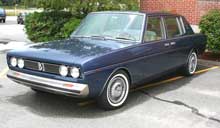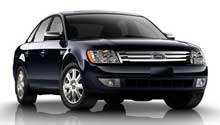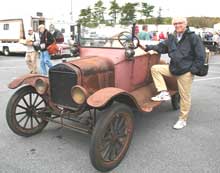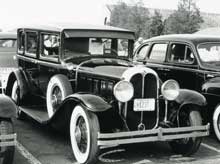Checker in High Ghia
A few years ago at Beaulieu Autojumble, I bought some interesting photos. Filed in a folder labeled "Checker" and stamped on the back as Ghia publicity pix, they showed four views of a very un-Checkerlike car. There was no nameplate visible, but a small checkered emblem on the grille exhibited a small section of the characteristic checkerboard pattern seen on many of Checker's operating cabs.
The conventional wisdom at the time was that it was a design study for a stillborn new-generation Checker cab. In fact, the car, bodied by Ghia, had been described as a Checker in several publications at the time of its 1968 appearance at the Paris Auto Salon. Most writers were uncomplimentary about its looks.
It turned up again at the 1969 New York Auto Show, this time described as the Ghia Centurion. It was exhibited by Rowan Industries (page 2) (page 3) of Oceanport, New Jersey, manufacturers of electrical equipment and, at one point, a small electric car also styled by Ghia. The Centurion's journey to New York was a bit convoluted.
In 1967, designer Tom Tjaarda was working for Giorgetto Giugiaro at Ital Styling, forerunner to Ital Design. Tjaarda, son of Dutch-born designer John Tjaarda, whose Sterkenberg designs were the inspiration for the original Lincoln-Zephyr, had been with Pininfarina before joining Giugiaro. His first project at Ital was drawings for the aforementioned Checker. Shortly thereafter, Tjaarda was summoned to Ghia to speak with its then-owner, Alejandro de Tomaso. He ended up being offered a job, and was assigned to the prototype model for the Checker project.
It seems the order had come in through de Tomaso's brother-in-law, an American named Amory Haskell, head of Rowan Industries. The exact nature of the original commission has never become clear. Some in the Checker enthusiast community insist it was ordered by a Middle-Eastern sheik. Others think it was Ghia's attempt to independently enter the limousine market after cancellation of the Ghia-built Imperial limos of 1957-1965. Still others believe it was Checker who coveted the limo trade. In any case, after appearing at the '69 New York show, the car remained unsold, and was not claimed by Checker. It was subsequently used by a Rowan official named John Corson Ellis at his home in Florida.
Ellis finally traded the car for some land in Washington State. Not long afterwards, he died in a plane crash, along with fellow passenger Haskell. The new owner registered the car, using its original manufacturer's certificate of origin, and drove it for a short time. By the mid-1970s, it had been relegated to storage under a tarpaulin, where it was discovered by a meter reader, who recognized it as an unusual vehicle and thought it might fetch an astronomical price on the collector market.
Unfortunately, the ensuing years had not been kind to it. Three coats of paint were beginning to chip off, and the interior, ravaged by northwestern dampness creeping past deteriorated door seals, was in an advanced state of decay.
Steve Contarino of Haverhill, Massachusetts, bought the Ghia Centurion in January 2006 and commenced a total restoration, undertaken by Martel's Classic Carriages of Fitchburg. Completed in the summer of 2007, it now sports its original color of Cobalt Blue and an interior faithfully re-created in broadcloth to the correct pattern. It rides a Checker A-12 chassis, with 327 cid small block Chevy power and a Powerglide transmission. Unusually, and this was part of the original commission, it has "suicide" rear door on the left and a conventional forward-swinging door on the right - the rationale for this remains a mystery. It has aft-facing jump seats in the rear compartment, and a liquor cabinet with fine crystal decanter. The instrument panel has metric gauges, which suggests it was not intended for use in the U.S.
Some ask "If this was really a prototype, why did it never reach production?" The naysayers cite its unattractiveness, echoing the pundits of 1968-69. Perhaps, but beauty is in the eye of the beholder. To my eye the Centurion is a good deal more attractive than Checker's standard A-12.




